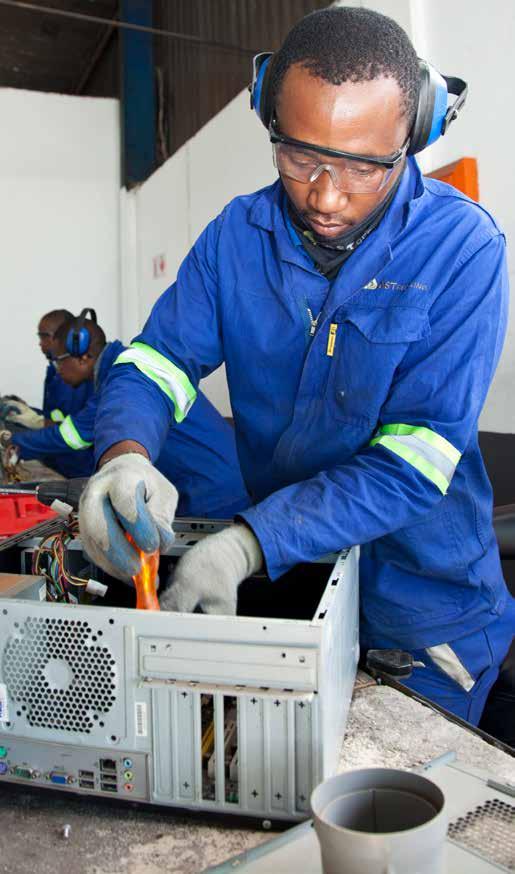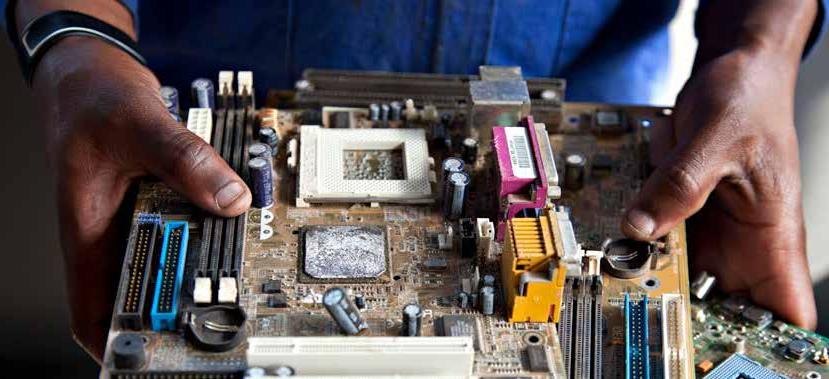
7 minute read
HOT SEAT
by 3S Media
Taking a HOLISTIC APPROACH to e-WASTE
South Africa’s electrical and electronic equipment (e-waste) industry offers huge potential for SMMEs and largerscale businesses within the circular economy. ReSource speaks to Malcolm Whitehouse, general manager at AST Recycling, about the company’s strategic vision as an e-waste, IT asset management and IT asset disposal leader.
Advertisement
How formalised is South Africa’s e-waste industry and what’s the best way to grow it?
MW The e-waste industry in South Africa remains fragmented and the legislative framework to regulate it is still in progress. To move forward, we need a formalised and integrated strategy from government that can be implemented and practised uniformly so that every participant across the supply chain is empowered, be they OEMs, informal waste pickers, SMMEs or specialist e-waste recyclers like AST.
According to the latest e-Waste Association of South Africa (eWASA) report, only 7% to 12% of e-waste is being formally recycled. Clearly, this indicates that there’s a great deal of informal activity, since eWASA estimates that South Africa generates about 6.2 kg of e-waste per inhabitant annually.
E-waste is a secondary resource material. You can recover up to 99% of what’s in any device, so the market is there if we can mobilise it more effectively as an industry.
What are AST’s e-waste ISO credentials?
We’re a pioneer in fully integrated ITAM/ITAD (IT asset management/IT asset disposal) and final e-waste recycling in South Africa. In addition to our Second-Hand Goods licences, we are ISO 9001, ISO 14001 and ISO 27001 certified. We are also preparing for ISO 45001 certification, in addition to ISO 37000 and ISO 44001, the latter two are more specifically focused on anti-bribery and anti-corruption, as well as collaborative relationships – which are especially important for our international business expansion. We also adhere to the Basel Convention.
What services do you offer?
We’ve expanded our business to provide a holistic bouquet of services. In this respect, our services extend beyond e-waste recycling to include a full turnkey solution comprising ITAM and ITAD.
Our ITAM services include a review of current software and hardware used, ensuring licensing compliance, tracking how ICT assets are being used and where changes may be needed. We also assess a client’s existing software to determine network security. Our goal is to maximise cost efficiencies and ROI within an organisation’s ICT environment.
We follow globally accepted best practice standards in terms of all our refurbishment protocols. We are also a registered supplier of new ICT equipment. On refurbished and disposed products, data sanitisation software ensures that any information is not forensically recoverable, helping us and our clients to fully comply with the POPI (No. 4 of 2013) Act.
What’s the potential market for South Africa and Africa?
The circular economy model is not an academic debate – it’s a well proven and vital system for recycling and reusing every commodity we can. In South Africa, we believe there’s an annual potential of close to R2 billion (assuming and based on known volumes of ICT e-waste placed on the market currently). The environmental imperatives are clear. In addition to this, there’s the massive potential to create a vibrant e-waste industry that could create thousands of new jobs.
Post Covid-19, we believe our business model will be a major factor in helping to stimulate socio-economic growth within our sector. We currently have a client base of around 3 500 customers. If you just factor this by four employees per entity, that’s around 14 000 people that benefit monthly.
Our customers ship from all over the country and we support them in return by paying above market rates. Our main facility is in Johannesburg. We also have a start-up in Cape Town, as well as KwaZulu-Natal.
Within Africa, we’ve identified Kenya and Ghana as major new markets for 2021, alongside our existing operations in countries that include Botswana, Mozambique, Nigeria, Zambia and Zimbabwe. There are also 19 other African countries on our strategic development roadmap.
At present, we export PC circuit boards to overseas specialist refineries for the extraction of their precious and base metals content. That’s because no local specialist PC board refinery exists. Our local refinery is geared for extraction of precious metals from ore, and not from PC boards. Over the longer term, our vision is to help promote the creation of local refining capacity in South Africa and Africa.

Will 2021 see the end of e-waste to landfill?
As an industry, we’re all striving for this in conjunction with the Department of Environmental Affairs and associated stakeholders. However, it’s not just about e-waste, since all recyclable waste streams need to be included in government’s zerowaste-to-landfill strategy. Ongoing consumer education is vital to promote responsible recycling along the lines of regions like Europe, where this culture is well entrenched.
Within the South African context, the reality is that, in most urban areas, the bulk of e-waste sent to landfill is picked up the same day by informal waste pickers specifically on the lookout for saleable materials.
What is the significance of the extended producer responsibility (EPR) scheme?
The EPR regulations, once implemented in terms of the National Environmental Management: Waste Act (No. 59 of 2008), will require all producers (anyone that manufactures, assembles or distributes any electrical or electronic device) to register with an approved PRO (producer responsibility organisation) – eWASA or ERA

for our industry. We fully support these EPR initiatives and will work closely to facilitate their fine-tuning and final development, once again, with all stakeholders concerned. I strongly believe that a collaborative approach from everyone concerned is the only way forward in this regard.
EPR extends beyond the end of life of the device, so OEMs will need to have programmes in place. But there’s a grey area in respect of the wholesale and retail market. How do you control this area? Either way, we need to ensure that our EPR scheme is relevant for Africa, since our circumstances are unique.

Is Africa still a dumping ground for e-waste from developed countries?
Some countries in Africa still do receive e-waste donations from the developed world. The question is: how much of that e-waste transitions to a second life? In many cases, it’s a small percentage, which is why this practice is generally referred to as deferred dumping.
Various countries are taking a proactive stance to manage e-waste more effectively, Kenya being a prime example. During 2021, the Kenyan government plans to introduce EPR legislation. This will stipulate that OEMs must use a local and compliant recycler.
What’s the potential for job creation and SMME development, and how has AST made a difference?
As we grow in scale, we will increasingly outsource our collection services. That leaves more room for SMMEs, where we already provide formal training, skills transfer, mentorship and business development. Our hope is that we can help transition informal waste pickers into successful businesses that create employment within their communities. Thanks to our business model, we’ve established a steady market for SMMEs to sell their e-waste. We also give back to the community and schools through our managed donations programmes.
Are municipalities and industry working together to create a meaningful e-waste landfill diversion strategy?
Managing bailing, compacting equipment and logistics costs are crucial factors in stimulating an effective waste diversion strategy, as is a formal market. Where materials recovery stations are installed, it’s vital to ensure that local waste pickers are supported.
In the past, we piloted the deployment of containers at shopping centres, with mixed results. Then and now, awareness of e-waste recycling remains a major challenge, but we’re working on it. For example, our model has changed: we are now offering up to 60% of the second-hand or refurbished retail value of the original device to motivate consumers to part with their old equipment. They then get paid out when it’s refurbished and sold. What can’t be fixed will be scrapped and recycled properly, again using globally accepted best practices and our ISO certified standards.
In 2021, we’re planning to reintroduce the recovery station concept by installing smaller-scale collection bins in secured residential areas.
Where to from here?
In building an e-waste economy, government and industry must work together to improve the ease of doing business and enable investment that is strongly based on industry expertise and adapted to suit local conditions. This includes how the funds generated by the EPR scheme are channelled back to ensure sustainable empowerment and job creation in the waste industry.
In terms of technology, we’re working with entities – locally and globally – to help us find solutions that work best in South Africa and Africa. That’s important, since the complexity of the e-waste and ICT segments is evolving rapidly. Thanks to our holistic approach, we continue to diversify successfully into new markets.
www.astrecycling.co.za











